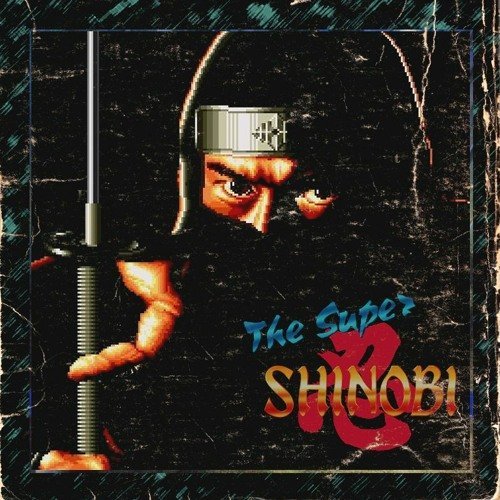Unleash Your Inner Ninja: The Enduring Legacy of SHINOBI, Sega’s Arcade Masterpiece
Step into the shadows, kunai in hand, and prepare for a challenge that has defined a generation of gaming. For over three decades, the name SHINOBI has resonated with arcade enthusiasts and console gamers alike, conjuring images of lightning-fast reflexes, acrobatic combat, and an unwavering commitment to justice. This isn’t just a game; it’s a testament to the golden age of arcade gaming, a classic side-scrolling action title that perfectly blends the mystique of the ninja with relentless, skill-based gameplay. If you’ve ever yearned to embody a deadly warrior, executing swift strikes and daring rescues, then SHINOBI is the retro gaming experience you’ve been waiting for.
From its humble beginnings in the bustling arcades of the late 1980s, SHINOBI carved out a unique niche, setting a high bar for ninja video games. It wasn’t merely about button-mashing; it demanded precision, patience, and a keen eye for enemy patterns. This article delves deep into what makes SHINOBI an iconic Sega classic, exploring its captivating gameplay, challenging design, enduring appeal, and practical tips for mastering its lethal art.
The Genesis of a Legend: SHINOBI’s Arcade Birth
In 1987, Sega, already a formidable force in the arcade game industry, released SHINOBI, starring the stoic ninja, Joe Musashi. At a time when arcade cabinets were the epicenters of gaming innovation, SHINOBI stood out. Its vibrant graphics, memorable sound design, and fluid animations immediately captured the attention of players. It wasn’t just another action game; it offered a sophisticated portrayal of ninja combat, blending agility, close-quarters combat, and ranged attacks into a seamless, thrilling package.
The game’s premise was straightforward yet compelling: Musashi, a master ninja, must rescue his kidnapped students from the evil organization known as Zeed. This simple narrative provided the perfect backdrop for five challenging missions, each culminating in a dramatic boss encounter. Players were instantly drawn into the high stakes, feeling the weight of their ninja duty with every shuriken thrown.
Mastering the Art of Combat: Gameplay Mechanics Explained
At its core, SHINOBI’s gameplay is deceptively simple, yet incredibly deep. You control Joe Musashi, navigating him through various varied stages, from bustling city streets to treacherous enemy fortresses.
How to Play:
- Arrow keys (or joystick in the arcade) guide Joe Musashi’s agile movements. Precision in movement is paramount, especially when dodging projectiles or performing acrobatic leaps.
- A/S/D keys (or dedicated action buttons) are your tools of destruction:
- Jumping (A): Essential for traversing platforms, avoiding ground attacks, and reaching higher enemies. Joe’s jumps are fluid, allowing for mid-air adjustments crucial for survival.
- Attacking (S): Joe primarily uses his katana for close-range combat. A single slash is often enough for weaker foes, but larger enemies or armored adversaries will require multiple hits. Mastering the timing of your strikes is a skill-based gameplay element that defines the SHINOBI experience.
- Throwing Shuriken (D): Your primary ranged weapon. You start with a limited number, but clever play can replenish your supply. Shuriken are vital for taking out distant enemies, flying threats, or initiating combat before getting too close.
The Perfect Blend of Stealth and Combat:
While the article highlights “stealth,” SHINOBI interprets it through a unique lens. It’s not about hiding in shadows (though you are a ninja, after all!). Instead, it’s about tactical engagement:
- Assessing Threats: Observing enemy attack patterns is your greatest weapon. Some enemies lunge, others fire projectiles, and some have distinct vulnerabilities.
- Strategic Engagement: Do you rush in with your katana, risking damage but conserving shuriken? Or do you whittle down a group of enemies from a distance with a shuriken storm before engaging the stragglers? This decision-making process is constant and adds immense replayability.
- Environmental Awareness: Using platforms to gain a height advantage, or recognizing when to retreat and regroup, are subtle forms of “stealth” in SHINOBI.
Rescue Hostages for Power-Ups:
Throughout each level, you’ll encounter chained-up hostages. Freeing them is not just an act of heroism; it’s crucial for survival. Hostages provide:
- Increased Shuriken: Replenishes your vital ranged arsenal.
- Special Ninja Magic: A powerful, screen-clearing attack that can turn the tide of battle. Use it wisely, as it’s a limited resource!
- Extra Lives: Sometimes, a hostage will grant you a much-needed extra life, extending your play session and giving you more chances to overcome the retro challenge.
An Authentic Ninja Experience: Visuals, Sound, and Atmosphere
SHINOBI’s impact extends beyond its gameplay. Sega crafted a world that felt authentic to its ninja theme:
- Fluid Combat and Acrobatic Moves: Joe Musashi moves with an impressive grace. His jumps are high, his slashes are swift, and his overall animation package was top-tier for its era, truly conveying the agility of a trained ninja.
- Vibrant Pixel Art: From the neon-lit cityscapes to the foreboding ninja fortresses, each stage is rendered with distinctive, colorful pixel art that remains charming to this day. Character sprites are detailed, allowing players to easily identify different enemy types and their threats.
- Iconic Soundtrack: The game’s music, composed by Yasuhiro Kawakami, is legendary. Tracks like “The Shinobi” and “Ninja Step” are instantly recognizable, imbuing the game with a sense of urgency, heroism, and the mysterious allure of the ninja. The sound effects – the satisfying “clink” of a shuriken hit, Joe’s grunts, and enemy cries – further immerse players in the action.
- Atmospheric Stages: Each stage presents a unique visual theme and set of challenges. You’ll battle through Japanese gardens, industrial zones, dark caves, and even atop a speeding train or helicopter. This variety keeps the game fresh and exciting.
The Retro Challenge: Tough but Fair Old-School Difficulty
One of SHINOBI’s most defining characteristics is its difficulty. This isn’t a modern game with regenerating health and endless checkpoints. This is old-school difficulty at its finest:
- Precision and Practice: Expect to lose lives and use continues. The game demands that you learn from your mistakes, memorize enemy patterns, and hone your reflexes. It’s a true test of skill, not luck.
- Limited Resources: With a finite number of lives and the strategic use of special magic, every decision matters. Careless play is swiftly punished.
- Boss Battles: Each of the five main missions culminates in a unique boss fight. These encounters are often multi-stage, requiring specific strategies and perfect timing to defeat. From the giant mechanical spider to the agile Lobster Man, each boss is a memorable obstacle.
- The Learning Curve: While challenging, SHINOBI is rarely unfair. Every death provides a lesson, and with enough perseverance, mastery is achievable. The satisfaction of finally overcoming a particularly tough segment or boss is immensely rewarding, a hallmark of challenging platformers from this era.
Ninja Tip: Watch for enemy attack patterns and strike when they’re vulnerable! This single piece of advice is gold. Every enemy in SHINOBI has a predictable rhythm. Learn it, and you’ll find openings for attack or safe zones for dodging. Patience and observation are your greatest allies.
Beyond the Arcade: SHINOBI’s Enduring Legacy
SHINOBI’s success in the arcade quickly led to its porting to various home consoles and computers, including the Sega Master System, Nintendo Entertainment System, and various home computers. While these ports often featured slightly altered gameplay or graphics due to hardware limitations, they allowed a wider audience to experience the authentic ninja action.
The game’s immense popularity also spawned a highly successful and influential franchise:
- The Revenge of Shinobi (1989): A groundbreaking sequel for the Sega Genesis/Mega Drive, pushing boundaries with its graphics, music (Yuzo Koshiro!), and deeper gameplay.
- Shinobi III: Return of the Ninja Master (1993): Often considered one of the greatest 16-bit action games ever made, refining the formula to near perfection.
- Shinobi Legions (1995): A 32-bit entry for the Sega Saturn.
- Shinobi (2002): A bold reinvention for the PlayStation 2, offering a challenging 3D action experience.
- Shinobi (2011): A 3D entry for the Nintendo 3DS, harkening back to the classic side-scrolling style.
The SHINOBI series, initiated by that first Sega arcade classic, has left an indelible mark on gaming history. It influenced countless other action-adventure games and firmly established the ninja as a viable and popular protagonist in video games. Its blend of fast-paced action, intricate level design, and a demanding difficulty level set a precedent for many titles that followed.
Why SHINOBI Still Captivates Today
In an era of hyper-realistic graphics and sprawling open worlds, why does a pixelated vintage gaming experience like SHINOBI continue to draw players?
- Nostalgia Factor: For those who grew up with it, SHINOBI is a direct link to cherished childhood memories and the thrill of the arcade.
- Timeless Gameplay: The core mechanics of running, jumping, slashing, and throwing shuriken are universally enjoyable and haven’t aged a day. The focus on skill over spectacle ensures its lasting appeal.
- Accessibility: Thanks to emulators, modern game collections (like the Sega Ages line), and even fan-made ports, SHINOBI is more accessible than ever, allowing new generations to discover its magic.
- The Thrill of Mastery: In a world where many games hold your hand, SHINOBI offers a genuine sense of accomplishment. Overcoming its challenges feels earned and deeply satisfying. It’s a game that respects your intelligence and rewards your perseverance.
Practical Tips for Aspiring Ninjas
Ready to answer the call of the shadows? Here are some expanded ninja tips to help you prove your mastery:
- Master Your Movement: Joe Musashi is incredibly agile. Practice short hops, full jumps, and learn to combine them with attacks. Your ability to quickly move in and out of danger is key.
- Conserve Shuriken (Initially): While powerful, shuriken are limited. Use them for distant threats, enemies with shields, or flying adversaries. For ground-based enemies that aren’t firing back, a well-timed sword slash is usually more resource-efficient.
- Learn Enemy Patterns: This cannot be stressed enough. Every enemy, from the basic grunt to the end-of-level boss, has a predictable attack pattern. Spend a few moments observing before you commit to an attack.
- Utilize Power-Ups Wisely: Don’t just grab every hostage’s power-up blindly. If you’re close to a boss and have a full shuriken supply, maybe save that “special magic” for the perfect moment during the boss fight.
- Patience is a Ninja’s Virtue: Rushing headlong into battle is a quick way to lose lives. Take your time, clear areas methodically, and prioritize your safety over speed.
- Practice the Bonus Stage: The first-person bonus stage where you throw shuriken at incoming ninjas can earn you extra lives. Practice your aim and timing there!
The Shadows Are Calling
SHINOBI is more than just a classic video game; it’s a cultural touchstone that defines a pivotal era in gaming. Its blend of exhilarating action, challenging difficulty, and unforgettable atmosphere continues to captivate players worldwide. Whether you’re a seasoned retro gaming veteran seeking a nostalgic trip or a newcomer eager to experience a true arcade classic, SHINOBI offers an unparalleled journey into the heart of ninja combat.
Are you ready to wield the katana and shuriken, rescue the innocent, and become the legendary ninja Joe Musashi? The challenge awaits, and the satisfaction of victory is a reward worth fighting for.
Play SHINOBI now for FREE and prove your ninja mastery! 🏯🥷

